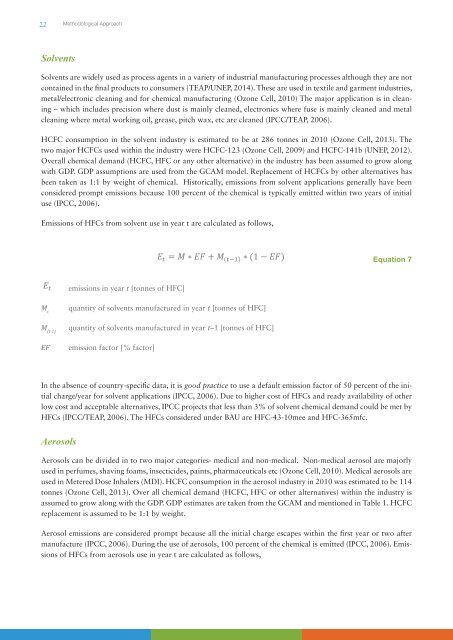Hydrofluorocarbon Emissions-Shakti Sustainable Energy Foundation
One such critically important category of gases is hydrofl uorocarbon (HFC). HFCs are potent greenhouse gases and are expected to contribute signifi cantly to global warming by 2050 (IPCC/TEAP, 2006; Velders et al., 2009; Gschrey et al., 2011; Miller & Kuijpers, 2011; Höglund-Isaksson et al., 2013). Read more information visit: http://shaktifoundation.in/report/indias-long-term-hydrofluorocarbon-hfc-emissions-detailed-cross-sectoral-analysis/
One such critically important category of gases is hydrofl uorocarbon (HFC). HFCs are potent greenhouse gases and are expected to contribute signifi cantly to global warming by 2050 (IPCC/TEAP, 2006; Velders et al., 2009; Gschrey et al., 2011; Miller & Kuijpers, 2011; Höglund-Isaksson et al., 2013). Read more information visit: http://shaktifoundation.in/report/indias-long-term-hydrofluorocarbon-hfc-emissions-detailed-cross-sectoral-analysis/
Create successful ePaper yourself
Turn your PDF publications into a flip-book with our unique Google optimized e-Paper software.
22<br />
Methodological Approach<br />
Solvents<br />
Solvents are widely used as process agents in a variety of industrial manufacturing processes although they are not<br />
contained in the final products to consumers (TEAP/UNEP, 2014). These are used in textile and garment industries,<br />
metal/electronic cleaning and for chemical manufacturing (Ozone Cell, 2010) The major application is in cleaning<br />
– which includes precision where dust is mainly cleaned, electronics where fuse is mainly cleaned and metal<br />
cleaning where metal working oil, grease, pitch wax, etc are cleaned (IPCC/TEAP, 2006).<br />
HCFC consumption in the solvent industry is estimated to be at 286 tonnes in 2010 (Ozone Cell, 2013). The<br />
two major HCFCs used within the industry were HCFC-123 (Ozone Cell, 2009) and HCFC-141b (UNEP, 2012).<br />
Overall chemical demand (HCFC, HFC or any other alternative) in the industry has been assumed to grow along<br />
with GDP. GDP assumptions are used from the GCAM model. Replacement of HCFCs by other alternatives has<br />
been taken as 1:1 by weight of chemical. Historically, emissions from solvent applications generally have been<br />
considered prompt emissions because 100 percent of the chemical is typically emitted within two years of initial<br />
use (IPCC, 2006).<br />
<strong>Emissions</strong> of HFCs from solvent use in year t are calculated as follows,<br />
<br />
Equation 7<br />
<br />
emissions in year t [tonnes of HFC]<br />
M t<br />
quantity of solvents manufactured in year t [tonnes of HFC]<br />
M (t-1)<br />
quantity of solvents manufactured in year t–1 [tonnes of HFC]<br />
EF<br />
emission factor [% factor]<br />
In the absence of country-specific data, it is good practice to use a default emission factor of 50 percent of the initial<br />
charge/year for solvent applications (IPCC, 2006). Due to higher cost of HFCs and ready availability of other<br />
low cost and acceptable alternatives, IPCC projects that less than 3% of solvent chemical demand could be met by<br />
HFCs (IPCC/TEAP, 2006). The HFCs considered under BAU are HFC-43-10mee and HFC-365mfc.<br />
Aerosols<br />
Aerosols can be divided in to two major categories- medical and non-medical. Non-medical aerosol are majorly<br />
used in perfumes, shaving foams, insecticides, paints, pharmaceuticals etc (Ozone Cell, 2010). Medical aerosols are<br />
used in Metered Dose Inhalers (MDI). HCFC consumption in the aerosol industry in 2010 was estimated to be 114<br />
tonnes (Ozone Cell, 2013). Over all chemical demand (HCFC, HFC or other alternatives) within the industry is<br />
assumed to grow along with the GDP. GDP estimates are taken from the GCAM and mentioned in Table 1. HCFC<br />
replacement is assumed to be 1:1 by weight.<br />
Aerosol emissions are considered prompt because all the initial charge escapes within the first year or two after<br />
manufacture (IPCC, 2006). During the use of aerosols, 100 percent of the chemical is emitted (IPCC, 2006). <strong>Emissions</strong><br />
of HFCs from aerosols use in year t are calculated as follows,

















